How to help wildlife

Capturing the





You will read on page 6 that Andrew Impey has stepped down as the Trust’s Chief Executive Officer after eight and a half years. I would like to personally pay tribute to Andrew’s impact on the Trust and his dedication over many years.
Following on from my previous role as Deputy Chief Executive, the Board of Trustees have appointed me as Interim Chief Executive Officer. I will lead the Trust for a minimum of six months while we put in place a plan to recruit Andrew’s long-term successor.
Our focus remains constant, however: to protect wildlife and inspire a lifelong love of nature in Essex. As Andrew says in his farewell letter, people are at the heart of the Trust. We have an incredible community of members, volunteers, staff, and supporters, and I look forward to seeing what we can achieve together for the common cause in the months ahead.
Rich Yates Interim CEO and Director of EngagementWildlife Trust
four times a year: Spring, Summer, Autumn and Winter
No. 126 Spring 2024 ISSN 2756-0066
All enquiries to:
Essex Wildlife Trust, Abbotts Hall, Great Wigborough, Colchester, Essex, CO5 7RZ
T 01621 862960
E enquiries@essexwt.org.uk www.essexwt.org.uk
Reg Charity No. 210065
VAT Reg No. 945745977
Company Reg No. 638666 England
The Trust is a corporate member of The Wildlife Trusts.
The views expressed in this publication are not necessarily those of the Trustees of Essex Wildlife Trust.
We are the county’s leading conservation charity, committed to protecting wildlife and inspiring a lifelong love of nature.
We manage nature reserves and discovery parks across the county, providing outstanding outdoor learning and preserving places of wonder.
Founded in 1959 by volunteers, we protect over 100 sites across Essex and are supported by 40,000 members.
Our climate is in crisis and nature needs our help. Together we can protect the future. Join us.
We are one of the largest Trusts that work together throughout the British Isles as The Wildlife Trusts.
‘We have an incredible community of members, volunteers, staff, and supporters.’
We need your help!
Join the fight against litter
Editor-in-Chief
Lauren Cosson
Executive Editor
Rich Yates
Editor
Bailey Tait
Editorial Assistants
Charlotte Mugliston, Francesca Chantry and Gemma Cosson
Art Director
Lottie Hall
Designer
Tasha Mound
Advertising
Jamie Watt
To advertise in WILD magazine contact Jamie on marketing@essexwt.org.uk
Printing The DS Group
magazine
conform to the British Code of Advertising Practice.
Copyright © Essex Wildlife Trust 2023
There’s over 1.5 million of us living in Essex, if we all pick up a few pieces of litter and dispose of them correctly, we can make a huge difference. Sign up to our Spring Pickers campaign at www.essexwt.org.uk/pickers
Pledge to go peat-free
Preserve our precious peatlands by avoiding compost containing peat. Find a list of supportive retailers at www.essexwt.org.uk/ actions/how-go-peat-free-home
Make a bee hotel
Open up a hotel with a ‘buzz’ in your garden, providing solitary bees with a safe place to nest. Simply follow our instructions at www.essexwt.org.uk/actions/ how-make-bee-hotel
Ready… set… go wild
It’s almost time to sign up to 30 Days Wild and feel happier, healthier and more connected to nature! Register your interest now at www.wildlifetrusts.org/30dayswild
We really hope you enjoy receiving your magazine. If, however, you would prefer to convert to our digital-only Green Membership, please contact the Membership Office on 01621 862964 or by email at members@essexwt.org.uk
We will be delighted to help you manage how we communicate with you.
competition
After a record-breaking number of entries, marvel at the winners of each category and find out who was crowned Essex Wildlife Trust’s Photography Competition 2023 winner.


A farewell letter to members from Andrew Impey.
Updates from throughout the Trust on our work to protect wildlife and inspire a lifelong love of nature.
Dive into the season with exciting events and challenge yourself to tick off our sensory spring checklist.
Nature’s number one hit. Meet the lead singers and find out the best places to hear it this spring.
How we can use technology to deepen our connection with nature.
From well-worn paths to well-kept secrets, we’ve got all the best spots to see flowers this spring.
Updates from The Wildlife Trusts movement on national projects and campaigns for wildlife.
Test your knowledge of our natural world with our fun wildlife crossword.
Find out what baby badgers look like and how they organise their setts. Learn everything you need to know about the UK’s largest land predator, and the face of Essex Wildlife Trust.

From the squelching saltmarsh underfoot to the kestrels hovering in the sky above, discover the history and wildlife of Two Tree Island nature reserve.
Find out how a dandelion transforms from a tiny seed to your wish on the wind.


Dear member,
After almost eight and a half years at the Trust, I have decided that it is time for me to step aside and let someone new take the reins. My wife has suffered ill-health over the last few years and now faces more surgery and this has been a major consideration in my decision to step down from my role, as I look to support her through her lengthy recovery, post operation.
The Trust is, in many aspects, unrecognisable from the charity that I joined back in 2015 and it is now incredibly well equipped to deal with the many challenges that lie ahead, to secure that ultimate vision of a county rich in wildlife, with people connected to nature.
From my perspective, it’s simply impossible to list all the changes and improvements that have been achieved over the last eight and a half years. Our focus on wildlife protection and habitat improvement has always been at the centre of our planning and operating and I’m delighted that the Trust now has a focus on conservation evidence – collecting species data – so that we can quantify our impact to our funders and supporters; plus we have recognised just how important our coastal and marine work is to our future ambitions, in our wonderful county.
We opened three new Nature Discovery Centres during my time at the Trust; we restructured our Wilder Learning provision, we grew our external profile
across all media channels, and we developed ambitious new projects, such as our outstanding Nature Nursery, to show leadership and ambition, in response to a general population that is eager for leaders to step up and give nature a voice.
People are at the heart of the Trust, and the numbers speak for themselves. We have almost 20% more members than we did when I started, we are receiving well over twice as many visitors to our centres, and we have three times as many volunteer hours being delivered, across all aspects of our work.
I don’t have an opportunity to thank all those incredible individuals – staff, volunteers, members and supporters – who have supported me throughout my time at the Trust, but I wanted to say a heartfelt thank you to you all. This is a wonderful organisation, with some incredible individuals, passionate about wildlife protection and totally committed to conserving wildlife in Essex in perpetuity.
Everything that I have done for the Trust had one overriding principle at heart – what is best for the Trust. I’m sure the person who follows me will have the same strong values, and I wish them every success.
Stories and news from throughout the Trust on our work to protect wildlife and inspire a lifelong love of nature across Essex. Written by our staff, volunteers and members of our Local Groups.
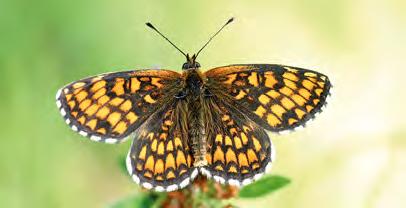
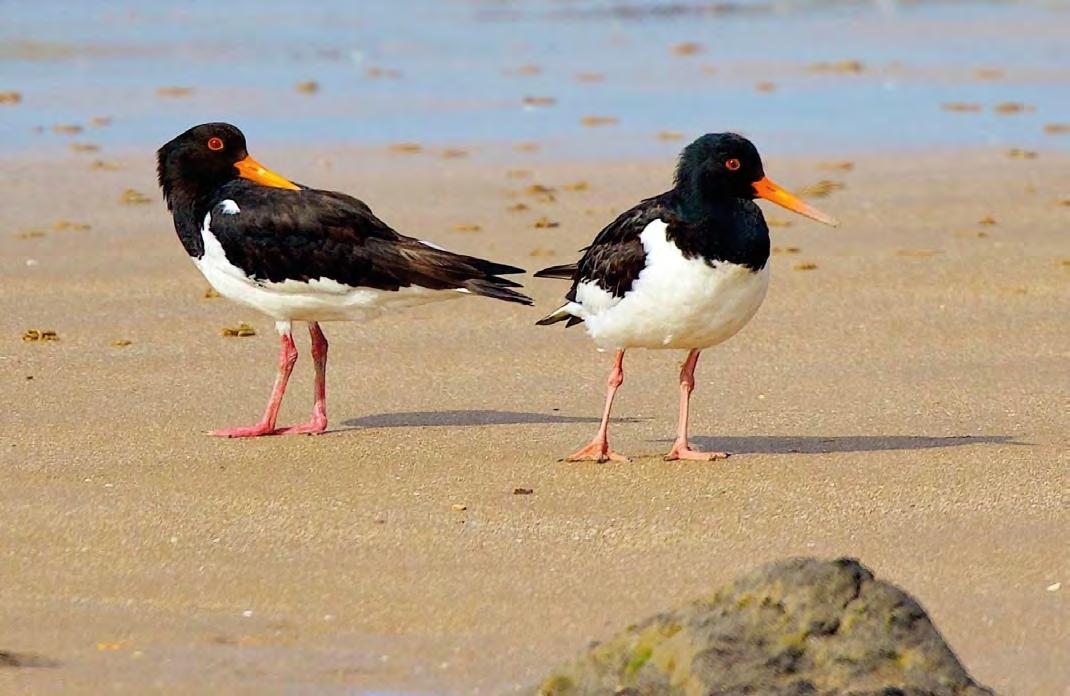

Share Our Shores is a collaboration between Essex Wildlife Trust and the RSPB to help raise awareness of, and conserve, our beach-nesting birds: little terns, oystercatchers and ringed plovers. 2023 saw huge successes including the best breeding year for the amber-listed little terns since 2003 in Hamford Water, Walton-on-the-Naze. At Colne Point nature reserve, using motion sensing cameras, we were able to discover the outcome of every nest for the first time ever.

Cameras also caught instances of disturbance, with people walking, biking, camping, and even partying just a few metres away from active nests. When nests are disturbed parents will temporarily flee and if disturbed for too long it can lead to the nest failing.
In 2024, funding will allow us to trial new interventions to protect vulnerable ringed plover nests from humans and predators alike.
Heath fritillary: Jim Higham
Black-tailed godwit: Amy Lewis
Harry Elliott Conservation Ecologist
Black-tailed godwits are a vulnerable species that mostly breed in Iceland but are found on the Essex coast in winter where they feed on the invertebrates in the mud. Coastal marshes are really important for this species as they gather in their thousands. Recently, an exciting sighting was made by volunteer Tim Haywood, revealed by data from its colour rings (a way of tagging birds) provided by the University of East Anglia. The black-tailed godwit spotted during a winter bird survey at Fingringhoe Wick Nature Discovery Park was rung as an adult in 1998 in Norfolk, making this bird at least 26 years old and one of the oldest of its species ever recorded!
The Conservation Evidence Team continue to monitor breeding birds, to gain valuable data that will inform conservation works, protecting their future.
In comparison to 2022’s report of 101 different bird species, 2023’s survey recorded 107 different species, of which 102 are known to breed in Essex. The top four most frequently recorded species were: wood pigeon, blue tit, robin and wren. We are pleased to report that Danbury Ridge nature reserves remain a breeding ground for lesser spotted woodpecker, with records of fledged young noted. Other exciting findings during surveys included firecrest, spotted flycatcher and ring ouzel.

Darren Tansley Wilder Rivers and Protected Species Manager
Recently, the Waterlife Recovery Trust has announced the results of a ground-breaking trial demonstrating that eradicating mink across East Anglia can happen successfully, to help water vole populations recover. The trial was developed by a group of conservation charities in 2019, including Essex Wildlife Trust. This partnership grew into the Waterlife Recovery Trust.
Since 1950, water voles have declined by 96%. American mink is an invasive species that predate on water voles and are a huge factor into their decline. Until this trial, mink have never been successfully eradicated from any part of Britain. This shows that a mink-free Britain is now a realistic ambition.
The Trust has been involved in water vole recovery for 20 years, so the success of this initial pilot in removing mink from almost 6,000km of East Anglia is a cause for celebration in the conservation world. This region is currently the only one in the UK with a naturally recovering water vole population, and funding has been secured to roll this out across remaining rivers in Essex. We look forward to updating about our water vole recovery project in the coming months.



Last spring, 271 of you took part in the first year of Butterfly Seekers, recording 10,155 butterfly sightings across Essex. Thank you to everyone who took part and helped us collect over 10 times the number of records we set out to gather. Your important data will help us to understand more about butterfly populations and distributions across our county so that we can ensure Essex butterflies thrive once again.
If you can’t wait to take part again or missed out last year, don’t worry as Butterfly Seekers is returning. From 1 March, you can record your butterfly sightings by downloading the ArcGIS Survey 123 app and fill out the Butterfly Seekers survey. You don’t need to be an expert to take part, just select the photo that looks most like your butterfly. You can find everything you need to know to take action for butterflies at www.essexwt.org.uk/butterfly-seekers
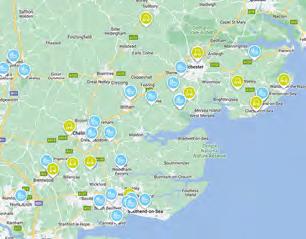

From October until January, people across Essex transformed their gardens into toad havens through our Nature Neighbours campaign. With 44 plots of log stacks, upturned plant pots, leaf piles and mini-ponds on our virtual map, our warty friends were spoilt for choice. We’ve also had over 1,800 of you tune in to our two Toad Talks with Froglife which are available to watch on our Instagram (@essexwildlifetrust) any time. So far, we have welcomed hedgehogs and now toads into the gardens of Essex. Who will we invite next autumn? You can read all our existing hedgehog and toad guidance at www.essexwt.org.uk/nature-neighbours

In The Wildlife Trusts’ Great Big Nature Survey, Essex members and supporters voted pollution as the biggest threat to nature. With far-reaching negative impacts across so many of our cherished species and habitats, it’s time to act. Become a Spring Picker by collecting five pieces of litter (or more!) each day from 9 - 18 March, to help us create a litter-free county in time for spring’s arrival. From enchanting woodlands, meadows, and parks, to captivating rivers and coastal areas, we want to clean up the county for our wildlife, and for us. It doesn’t matter who, or where, you are in Essex, anyone can join Spring Pickers. What are you waiting for? Get your ‘five-a-day’ in a different way by signing up at www.essexwt.org.uk/spring-pickers
We are dependent on the natural world in every aspect of our lives. We need nature and we need wildlife. As our dedicated members, you don’t need convincing that Essex boasts some of our most important wildlife and habitats in the UK that deliver real benefits as well as delight us.
This year, we will all be offered the chance to vote for the Government we want to take our country to 2030 which has been coined the point of no return for nature. It is no longer enough to simply protect what remains. We need the next Government to put nature into recovery, on land and sea, for the sake of both people and planet. The Trust will be engaging with local MP candidates, to stress the important role that nature must play in minimising the impact of climate change, improving the wellbeing of our community and securing sustainable farming. When we are called upon to vote this year, we all have an opportunity to make a difference, to vote for nature. Ahead of the election, check the Trust’s website for a hub of information about how you can protect nature with your vote.
Polluted ecosystems
Poor mental health
Loss of wildlife
Unsustainable farming
Nature

Essex Ecology, the consultancy of Essex Wildlife Trust, has been carrying out surveys for the Greater Anglia Wildlife Friendly Stations Accreditation Scheme. So far, Essex Ecology has visited nine stations in Essex to assess their potential for wildlife and suggest improvements in nature’s favour. Advice ranged from removing invasive plants, to putting hedgehog holes in fences, leaving banks of branches for wildlife to shelter or cutting the grass less to encourage growth. These visits showed the range of innovative efforts to nurture nature as part of the project. For example, this impressive insect hotel made with clay, sand and other materials at Alresford Station.
Beyond the financial contributions, Collier & Catchpole’s engagement with the Trust carries a deeper significance. Tim Rowbottom, Managing Director, has ardently embraced the role of an Investor in Wildlife for an impressive 20 years. Throughout this enduring partnership, Tim has meticulously preserved every certificate dating back to their membership’s inception in 2004. Tim takes immense pride in showcasing his steadfast support for the Trust. He confirms that they prominently display their certificate to both customers and clients, highlighting their dedication to wildlife and their pursuit of a better world. Tim, your unwavering commitment is truly appreciated. Your dedication serves as a wellspring of inspiration, reinforcing the value our corporate partners place in our mission.

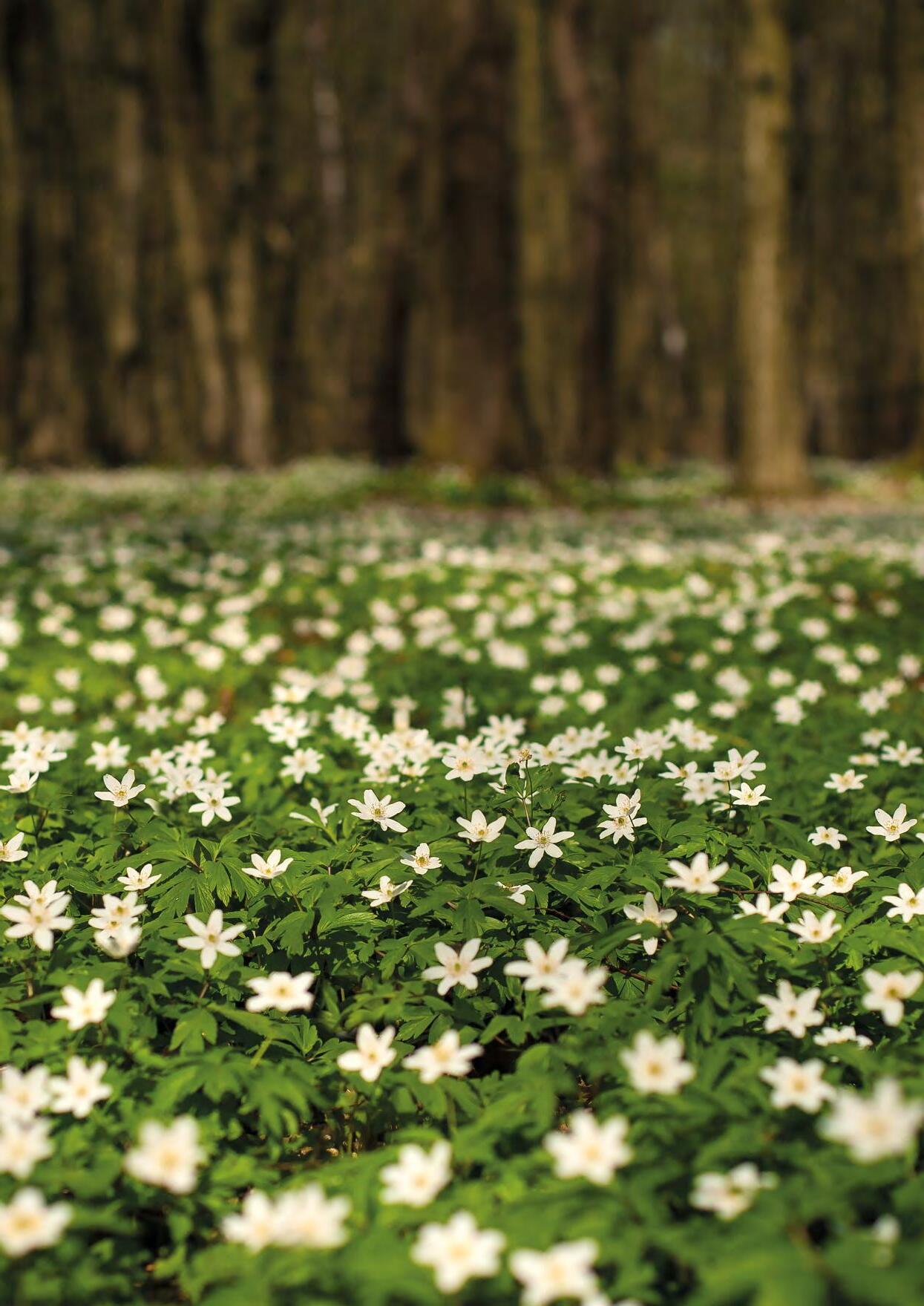
On 19 March, Braintree Local Group will be holding their Annual General Meeting (AGM) followed by an illustrated talk on amphibians by Jon and Ray Cranfield. The talk will include the opportunity to see live amphibians.
On 16 April, Greg Conway from the British Trust for Ornithology (BTO) will be giving a talk on nightjar ecology and migration. For further details about these talks please go to Essex Wildlife Trust’s events webpage: www.essexwt.org.uk/events/local-groups
We are back to a full cycle of events with four spring talks. Our 27 March talk will be preceded by a short AGM to which we encourage supporters to hear about our activities and elect a new committee. Even if the AGM doesn't appeal, come along for the South Essex Wildlife Hospital talk immediately afterwards. 'All about bats' by Essex Wildlife Trust’s Kim Wallis on 24 April should be interesting too. Our ever-popular plant sale at Hanningfield Reservoir is on Monday 6 May for which donations, delivered on 5 May, or before 10am on the day, would be gratefully received. Thank you, as more plants and buyers help to raise lots of valuable funds.
Gary Broad, Treasurer
The Southend Rochford and Castle Point area has in excess of 2,600 Trust members. However due to a number of factors including loss of committee members and Covid-19, the Local Group has not been able to put on meetings recently. On a positive note, one member kindly volunteered to come onto our committee to assist the group and, between us, we decided that the Local Group is worth saving. It is our intention to re-launch the Southend and Rochford Local Group at this year’s AGM.
Please come along and consider joining our committee as we need enthusiastic people to lead the Local Group. If you are interested, please contact: sandrewtlg@gmail.com
Graham Clegg, Chair
We concluded our 2023 programme of events with an optimistic talk from RSPB expert, Mark Nowers, on efforts being made to save the turtle dove, whose numbers have declined significantly in recent times. We also had a walk around Old Hall Marshes on the Blackwater Estuary where we were well rewarded with the high number of bird species spotted. Our thanks go to all Local Group members for their donations last year, which enabled us to support several initiatives at local Trust reserves.
As we look ahead to spring, two committee members have diligently organised an interesting and varied programme of monthly talks and walks for the public. The most well-attended talk of last autumn was on South Essex Wildlife Hospital. The Rainham Marshes walk was decidedly chilly with plenty of birds but of only a few species, including pintail and gadwall. Follow our Facebook page, EWT Havering Group, for more information.
Last year, a beach walk and litter pick concluded our 2023 sessions. This visit was to tie in with our publication ‘Colne Point: Between Land, Sea and Sky' which is still available to purchase in Nature Discovery Centres, or via email: david.r.bain@gmail.com
We are pleased to announce our spring programme of events, including our ever-popular plant sale at Barnes Spinney on 7 April, a bluebell open day at Weeleyhall Wood nature reserve on 5 May and pond dipping at Great Holland Pits on 2 June. We’d love to see you there.
Tony Morton, Chair
Our Local Group work party continues to meet on Tuesday and Thursday mornings to carry out work on the Trust's nature reserves in our district. Winter has seen us concentrating on West Wood and Shadwell Wood to continue the coppicing that keeps them in good condition for the widest variety of wildlife. While we were working, we found a number of fungi, including shaggy parasols and stinkhorns
As winter’s icy touch blankets the landscape, it creates a spotlight for our most resilient wildlife. From the graceful deer that navigate through frosty forests, to the brilliant brent geese which make their epic migration to our shores. Look through the lenses of our members and supporters to catch a glimpse into the stories of some of our most captivating winter wildlife.



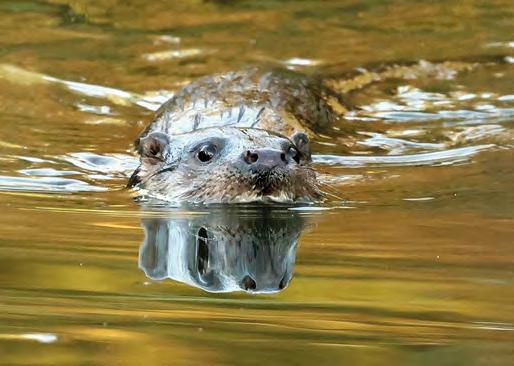
If you would like to feature in our next edition of WILD, please email your favourite images
Essex’s wildlife and wild places to magazine@essexwt.org.uk or tag Essex Wildlife Trust on social media.

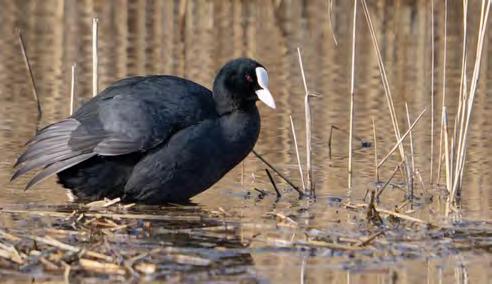

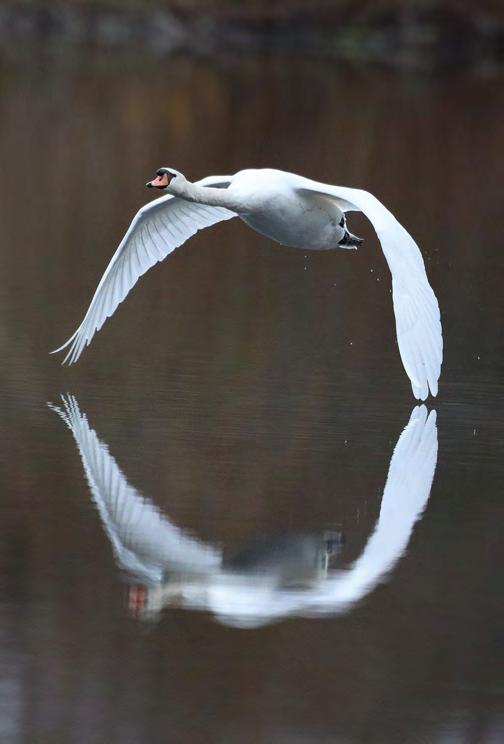

Can you smell that? Delivered on the spring breeze, the fresh scent of dew-drenched grass topped by sweet bursts of lilac, lavender and lily-of-the-valley. Nature is awake. Fawns take their first fumble on four legs, bunnies bound out of the burrow and cubs emerge from their cosy setts. Though this season may bring many animals their first glimpse of sunlight, us humans have been eagerly awaiting its return and what a grand return it is. Say goodbye to the glistening white sheet of frost and hello to captivating colours of spring.
Wildlife explorers revel in the extra hours of exploration as the sun spends longer and longer in the sky. The brighter mornings bringing a great opportunity to head out and hear the dawn chorus in all its glory. Bluebells blanket the floor beneath the branches. The fragrant aroma of honeysuckle hauls bees from afar to feast on its flowers. And the pitter-patter of pouring rain becomes the soundtrack to spring. What could be better?

Discover things to do and spot in March, April and May

We’ve created a handy checklist to cut out and keep, featuring some of spring’s most iconic scents. Challenge your friends and family to see how many you can tick off this season. Who nose what you might find?





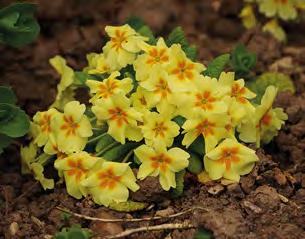






Smelt some of these? We’d love to hear from you. Tag us in your photos and videos on social media or send us a picture of your finds to magazine@essexwt.org.uk









• Saturday 9 March, 1.30-3.30pm
• Fingringhoe Wick Nature Discovery Centre, Fingringhoe, CO5 7DN
Join our monthly friendly group to knit and natter! Contact: 01206 729678, fingringhoe@essexwt.org.uk
• Saturday 23 March and Monday 20 May, various times
• The Naze Nature Discovery Centre, Walton-on-the-Naze, CO14 8LE
Daniel Bridge is running photography workshops to help you get the most from your camera. Contact: 01255 679379, naze@essexwt.org.uk
• Saturday 16 March, 6.30-9.30pm
• Abberton Reservoir Nature Discovery Park, Layer-de-la-Haye, CO2 0EU
Learn about constellations and use the telescopes to observe the moon, any visible planets and other objects in the night sky. Contact: 01206 73817
• Sunday 24 March, 2pm
• The Naze Nature Discovery Centre, Walton on The Naze, CO14 8LE
Join us for one of our popular beach cleans at this Walton-on-the Naze reserve. Contact: 07963 080335, pjcatte@gmail.com
• Various dates in April and May, various times
• Fingringhoe Wick Nature Discovery Centre, Fingringhoe, CO5 7DN
Join one of our guides on a walk round the reserve to discover the delights of the nightingale song. Contact: 01206 729678, fingringhoe@essexwt.org.uk
• Saturday 25-Monday 27 May, 10am-5pm
• Weeleyhall Wood nature reserve, Church Lane, Weeley, CO16 9AT
Tendring Local Group invite you to come along for refreshments and guided walks to see the bluebells. Contact: david.r.bain@gmail.com
• Saturday 25-Monday 27 May, 10am-5pm
• Langdon Nature Discovery Centre, Lower Dunton Road, Basildon, SS16 6EJ
Come along for a plant sale and some gardening advice to support Brentwood and Billericay Local Group. Contact: 01277 231305, chainbridge1009@gmail.com
• Sunday 29 May, 10am-3pm
• Hanningfield Reservoir Nature Discovery Centre, Billericay CM11 1WT
An event to raise awareness regarding support for people living with dementia. Includes fun activities, the dementia trail and stalls. Contact: justinc@essexwt.org.uk
Knitting: Surene Palvie, robin on camera: Chris Maguire, stargazer: Thirdman, bottle on beach: Maria Kray, house plant: Anna Shvets
As spring emerges, the birds are chirping a little louder, the flowers are blooming in vibrant colours, and the air is filled with the sweet scent of new beginnings. So, discover the wonders of wildlife at our beautiful nature reserves and Nature Discovery Centres and join us for an unforgettable season of wildlife discovery.

Annual General Meeting (AGM): Most AGMs are followed by an illustrated talk or guest speaker.
Braintree
Tuesday 19 March, 7pm - 9pm
Brentwood and Billericay
Thursday 21 March, 7.30 - 8pm
Chelmsford
Wednesday 27 March, 7.30pm - 9.30pm
Colchester
Thursday 21 March, 7.30pm - 9.15pm
Havering
Monday 11 March, 2pm - 3.30pm
Southend and Rochford
Thursday 21 March, 7.30pm - 8pm
Uttlesford
Wednesday 13 March, 7pm - 9pm


When you recycle food in your kerbside caddy, it is collected by your local council, taken for processing and turned into fertiliser and energy!
Find out how to recycle your food at home by visiting loveessex.org/food-recycling or scan the QR code using your smartphone’s camera
Saturday 22 june 2024
Join us at the Nuclear Races’ Wild Forest in Brentwood for a 5K like no other, as you take on obstacles, water – and raise vital funds for our wildlife and wild places in Essex.
Suitable for all abilities aged 13yrs+

Fundraising pledge £100

Registration fee £30

Book your space now at www.essexwt.org.uk/events/ running-wild or scan here

Where Colchester

Last autumn, eagle-eyed wildlife photographers across the county submitted their best wildlife captures for a chance to be crowned winner of Essex Wildlife Trust’s Photography Competition 2023. The competition ‘shuttered’ the already high expectations with over 1,000 entries. After much deliberation, the expert judging panel chose a winner for each category. Then, it was down to the public to choose their overall winner.
Matthew Thomas, this year's victor, captivated the public with 'I See You,' a stunning close-up of a fleecy jumping spider in his garden.
“I’ve always been into wildlife and have been interested in doing wildlife photography but was reluctant to spend all my money on a long lens for birds and larger wildlife. Thankfully macro photography is pretty accessible on a lower budget and of course there is so much to see literally in your garden or local park.
Macro photography allows you to delve into a world where every invertebrate has a very specific role within that particular habitat. And that habitat can change drastically over just a hundred metres, so in turn you start seeing different species. If you’re a bee for example, you’ll have a specific set of flowers (which only grow in a certain soil) to suit the shape of your tongue, and you’ll emerge to coincide with when they flower.
Capturing the picture ‘I See You’ was dumb luck really. My camera is usually set up at home for when I spot something interesting and quickly run into the house trying not to trip over my children’s toys in the process! Most of the time I’ll see something amazing, and it will fly off before I can take a shot but that is the nature of trying to shoot live subjects.”
Our panel of judges included Lottie Hall, Senior Graphic Designer, Andrew Armstrong, Senior Ranger and wildlife photographer, Jamie Watt, Marketing Manager and Bailey Tait, Campaigns and Advocacy Manager. Together, the six category winners were chosen.
A heartfelt thanks to all who submitted their pictures and voted for their favourites, making it another record-breaking year for the competition. We eagerly await the competition's return later this year. In the meantime, why not grab your camera and venture into the world of wildlife on your doorstep today.
 Jamie Watt Marketing Manager
Jamie Watt Marketing Manager
The Essex Wildlife Trust Photography Competition 2023 is kindly sponsored by High Chelmer.

“High Chelmer are delighted to support Essex Wildlife Trust’s Photography Competition and showcase this year’s winners. We hope that this will raise awareness amongst our shoppers to engage with wildlife and inspire them to be at one with nature. We are proud to display these unique visions captured throughout the county and help us appreciate the wonderful wildlife in our local surroundings.”
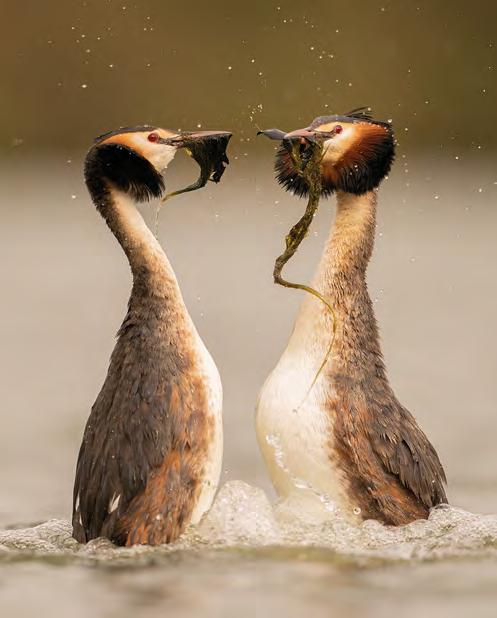
Name Weed Dance
Photographer Vai Meng Chan
Where Eastbrookend Country Park
One of wildlife’s most stunning mating behaviours, the dance of the great crested grebe, has been captured perfectly in the category; A Wildlife Motion Picture These elegant waterbirds rise out of the water before diving down to collect a bill full of soggy water weed – how romantic!

Name The Wolf
Photographer Beau Healy
Where Two Tree Island nature reserve
The judges couldn’t bee-lieve this capture of a female beewolf entered into the Young Blood category. The honeybee in the beewolf’s grasp has been paralysed. The stunned bee will sustain the wasp’s grub when it hatches in a den located in sand dunes.

Name Rainbow Over Beach
Photographer Francisco Javier Fernandez
Where Thorpe Bay, Shoeburyness
Francisco made waves with this entry in the Coastal Captures category. A double rainbow was captured framing Shoeburyness beach. This image shows the closeness of the coastal habitat for wildlife and the local community.

Name The Fox and the Friends Photographer Lee Spalding Where Benfleet
Urban or rural, the Wilder Essex category showcases a county full of species right on our doorsteps. This astonishing shot features a young fox staring directly down the lens, framed by blooming wildflowers and foraging magpies.
Name Sleeping Plasterer Bee
Photographer Matthew Thomas
Where Stanway Bypass
Celebrating all things bright and beautiful, Captivating Colours is always a tough category to judge. Matthew’s incredibly detailed image shows a plasterer bee resting on a flower head. If you look closely enough, you may see that it is sharing the flower with a family of aphids.

Although they didn't take the crown, these wildlife snaps received rave reviews by our judges.
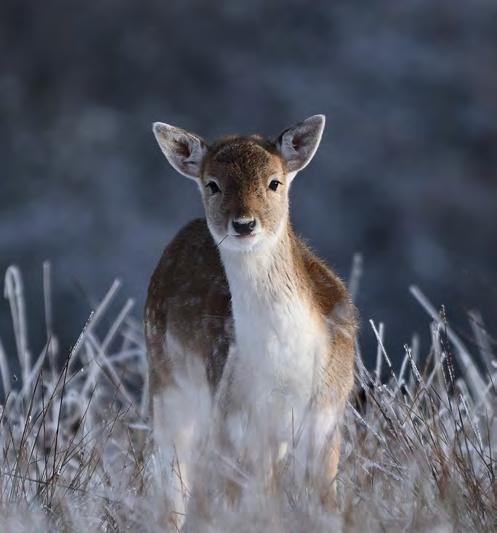
Category Wilder Essex
Photographer Claire Chown
Where The Manor Nature Reserve, Romford

Category Captivating Colours
Photographer Charlotte Prigmore
Where Cressing Temple Barns

Category Gardener's World
Photographer Roger Barker
Where A garden in Tendring

Category Coastal Captures
Photographer Kerri Webb
Where East Beach, Shoeburyness
Spring blesses us with new life. Cubs, chicks, pups, fawns, cygnets, kits and more are welcomed to the world, often under the cover of shelter, dens or nests. But fear not, because our live webcams will be taking you straight to the action. Follow the journey of our barn owls from egg to owlet or get a sneak peek of a badger clan and immerse yourself in wildlife from the comfort of your own home.
This stream is a real hoot! Coming to you live from Blue House Farm nature reserve, will we beat our nine-egg record this year?
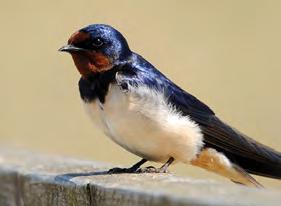
Swallows return to the UK in spring, ready to welcome their young. Follow their journey live from Fingringhoe Wick Nature Discovery Park.
Streaming live from Hanningfield Reservoir Nature Discovery Centre, keep your eyes peeled for coal tits, great spotted woodpeckers and, if you’re lucky, sparrowhawks.



Tiny soprano pipistrelle bats, the size of your thumb, come to give birth and rear their young. Watch the excitement unfold on our bat webcam.

See if you can catch a glimpse of our badgers emerging from their sett at Fingringhoe Wick Nature Discovery Park. Will it be mischievous cubs playing or an inquisitive adult heading out to forage?
An icon of British wildlife and the face of Essex Wildlife Trust, badgers are well known and a firm favourite for many nature lovers. They may be Britain’s largest land predator, but they are elusive creatures and their homes are even more so. As the sun begins to set, they emerge from their dwellings, foraging for dinner and exploring their surroundings under the cover of night. On the surface, badger homes aren’t much more than a D-shaped hole leading underground, but these secret hideaways are much more than meets the eye…
During the day, you can find badgers cosied up in their underground home, or ‘sett’. Setts are often a far cry from a simple abode, consisting of multiple tunnels, various rooms and several entrances. It’s no wonder that some of their underground complexes have taken years to build, with one sett previously discovered to contain over 50 entrances! Badgers are very particular about their homes, having separate rooms, or chambers, for different purposes; sleeping areas, escape tunnels, nurseries and toilets are all features of a badger’s elaborate residence. They’ll even keep it in tip-top shape by replacing their bedding (dry grass, bracken and other plants) regularly. Setts can take years to perfect, but it’s all worth it as badgers keep them in the family for generations to come.
Nothing rivals the cuteness of a baby badger, but a cuddly badger toy comes close. Bag one for yourself or a friend by adopting a species today at www.essexwt.org.uk/adopt-species
Badgers living together within a sett are called a clan, typically a multi-generational group of four to eight individuals. A large male keeps the clan in check, closely followed by a dominant female. This hierarchy is essential for larger clans, as some can have up to 35 members. Whatever the group size, badgers rely on their strong sense of smell to recognise and communicate with each other. Usually, animals living in groups reap benefits through hunting cooperatively. Not badgers. They opt to forage for earthworms and other tasty treats alone, but they do play together, groom each other and sometimes babysit.
In early to mid-February, females give birth to their single litter of the year. As females mate with various males, the cubs (usually two or three) can have different fathers. A fascinating yet rare social interaction between badgers is evident at this time of year, as females without cubs sometimes help those with. They may carry cubs, sleep next to them and change their bedding to remove parasites. When cubs reach 12 weeks old and emerge from the sett, babysitters chase away hostile animals and keep an eye on the cubs while they explore the outside world.


Just a stone’s throw from the popular coastal town of Leigh-on-Sea, this spectacular reserve shares its border with Essex’s largest river, the Thames. Smell the salt from the brackish water, enjoy the refreshing cool wind and immerse yourself in this dynamic landscape where wildlife thrives.
Glimpse the long, slender legs, curved bill, and black-tipped wings of the remarkable avocet.

Despite how they look, slow worms are actually legless lizards, not a worm or a snake. Keep an eye out for them basking in the sun around grasslands.

The south-facing sand banks provide burrowing homes for a range of bee species including mining, nomad and blood bees. Watch them dance from flower to flower sucking up delicious, sweet, sticky nectar.

Nothing welcomes back spring like the recognisable call of the cuckoo. These crafty birds are famous for laying their eggs in other birds’ nests, fooling them into raising their young.

Size: 298 hectares.
Address: Belton Way (by Leigh-on-Sea train station), Leigh-on-Sea, Essex, SS9 2GB
Access: Free car park on site for 30 cars.
Dogs: Dogs are allowed on site but between March-September please keep your dogs under effective control to avoid disturbing ground- nesting birds.

Before the 18th century, the nature reserve that exists today was submerged under the Thames Estuary. As demand grew for grazing and farming, an immense sea wall was constructed to hold back the tide and reveal the land beneath. When the appeal of farming faded, the landscape here was repurposed once more and in 1936, Two Tree Island nature reserve became a landfill.
After almost four decades of life as a wasteland, Essex Wildlife Trust saw the ecological potential of this underappreciated landscape and in 1974, took over management of the intertidal, easterly parts of the island, including saltmarsh and mudflats. Years later, in 2010, the remaining land that formed part of Hadleigh Castle Country Park was purchased by the Trust, with the exception of the model aircraft flying area.
Why is it called Two Tree Island?
The name comes from two large elms that grew on the west side of the island and were distinctive features that inspired the name. The name stuck even though these trees were brought down by storms in the early 1960s.
For years, Two Tree Island nature reserve was altered and adapted for human use. Thanks to careful conservation management over the years, this agricultural farmland and previous landfill is now serving a different purpose: being a home for wildlife. With a myriad of habitats from saltmarsh to mudflats, grassland to scrub, Two Tree Island supports an array of species in every season and has become a favourite site for birdwatchers and walkers alike.
Spring is a time when hibernating wildlife and returning migratory species appear at Two Tree Island nature reserve. Signalling the arrival of warmer seasons, calls of the familiar cuckoo fill the air. If you are lucky, you may even spot a fledged cuckoo chick, ready to explore their new home.
On the ground, returning reptiles may appear, although they are often shy creatures seeking solitude. Look for grass snakes, adders, common lizards and slithering slow


worms, all hoping to find a relaxing spot to bask in the warm sun before they look for a suitable partner to mate with. Reptiles aren’t the only ones looking for their partner. With an array of intertidal habitats, avocet, oystercatcher, redshank, ringed plover and black-headed gulls all depend upon this haven during the breeding season. Last year, we were excited to see tottering avocet chicks exploring the habitats here.
When summer arrives, Two Tree Island explodes into an insect extravaganza. Listen out for the buzz of bees as they busily flit between blooming wildflowers, in comparison to the quieter displays of delicate butterflies. In late summer, several important species of damselfly and dragonfly have been recorded, such as willow emerald and southern migrant hawker.
As autumn approaches, passage migration begins for many birds. Lots of these species find refuge at Two Tree Island before continuing their southwards journey. Throughout autumn and winter, large numbers of overwintering waders and waterfowl can be seen. Don’t miss the clattering and chattering of dark-bellied brent geese that feed on the dense eelgrass beds growing on the mudflats. For birds of prey lovers, short-eared owls can be seen swooping through grasslands searching for a feast.

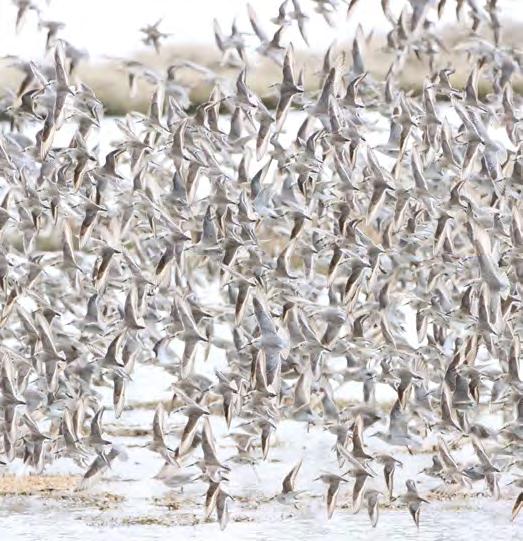
But no matter the time of year, this nature reserve is a paradise for many species. The pools which were once old sewage ponds are now a sanctuary for birds like kingfisher, teal, shoveller, grey heron, little egret and more. The eastern section of the island is where you can admire the stunning saltmarsh no matter the season. Look for the array of plant species such as golden samphire, sea purslane, common sea-lavender and sea aster, decorating the muddy marshes with vibrant colour.
Two Tree Island has a dedicated volunteer team of 15 local people that meet monthly in the winter and weekly in the summer to manage these special habitats. Here are examples of how this site is managed for wildlife:
The team have been restoring saltmarsh by installing 150 bundles of sweet chestnut brash, held in place by chestnut stakes, which provides a barrier to coastal erosion and allows sediment to build up. Saltmarsh plants can thrive on this habitat, absorbing carbon and helping us to fight climate change.
Several large areas of grassland are cut each year and raked to remove nutrients from the soil and encourage
‘Two Tree Island has a dedicated volunteer team of 15 local people that meet monthly in the winter and weekly in the summer to manage these special habitats.'
wildflowers to grow. With funding from the Ida Davis Foundation, six sand banks were also installed. These banks now provide burrowing and basking habitats for a range of bee species, as well as wasps and beetles.
By cutting back vegetation, nesting and roosting areas are created for waders by the lagoon. Additionally, beach-nesting birds like ringed plover and little terns will hopefully enjoy the newly-laid shingle and sand on the islands – replicating their usual habitat and encouraging waders to breed. Barn owl boxes have been installed to encourage roosting and breeding barn owls, as we often see barn owls hunting around the island.

Help us keep wildlife safe
We welcome everyone to visit this magical landscape but, unfortunately, we have seen the impact that human disturbance has on wildlife. We can all help protect this fragile ecosystem and keep disturbance to a minimum by keeping dogs on a lead and keeping to the marked tracks. With your help, we can continue protecting this vulnerable site for future generations.

Ali Morse, water policy manager at The Wildlife Trusts, warns of a return to the dirty history of UK waterways.



TAli Morse is water policy manager at The Wildlife Trusts. She works collaboratively across the movement, with all Wildlife Trusts and with other organisations, to call for better protections for the water environment.

he history of UK rivers has seen raw sewage, waste chemicals and heavy metals poured into watercourses day in, day out. Great rivers like the Mersey were practically devoid of life, and as recently as the 1950’s the River Thames was considered ‘biologically dead’. Today our rivers don’t (usually) resemble putrid open sewers lined with dead fish. Yet many problems remain – poor water quality poses a threat to nature, human health and our economy.
Headlines have exposed sewage spills, but the harm caused to wildlife is little understood. The UK Government’s Environment Act 2021 now requires water companies to monitor impacts and to prevent the most harmful spills. But even when wastewater is treated, the effluent from sewage treatment works may contain industrial chemicals, pharmaceuticals, household cleaning products, illicit drugs and microplastics. It’s also high in polluting nutrients like phosphorus, which fuel algal blooms, depleting oxygen and harming aquatic plants, insects, fish and other species.
Thanks to campaigning by supporters of The Wildlife Trusts and others, the UK Government was recently blocked from weakening water protections in places where nutrients are already harming sensitive rivers and coasts. These rules are known as nutrient neutrality and require developers to offset additional pollution from sewage from new housing. They help to prevent development from harming our most important wildlife sites.
Farming is the sector responsible for the greatest number of waters failing ecological standards. Excess fertiliser, manure, slurry and eroding soil can all deliver harmful doses of nitrogen or phosphorus to our rivers. Pesticides and veterinary medicines add into the mix. This toxic cocktail of chemicals also flows downstream, contaminating our seas.
Grants can help farmers to provide sufficient storage capacity for slurry and to manage rainwater from yards and roofs that contributes to runoff. Essential environmental schemes encourage farmers to plant cover crops and riverside ‘buffers’ to prevent soil erosion.
Despite these efforts, collectively these pressures mean our waters are under huge strain. Across the UK, only 36% meet ecological standards and are in good enough condition for wildlife. In England, where pressures are greatest, the figure is just 16%. Phosphorus pollution is the most common cause of failure, so water companies are required to upgrade numerous treatment works by 2030 to strip out phosphate, and more action will be needed from farming too.
From Dorset to Durham, Wildlife Trusts are finding novel ways to prevent nutrient pollution reaching our waters and creating habitat where nature can thrive. In Wiltshire, a chalk stream with habitat for spawning brown trout and endangered water vole is being protected by a restored wetland where road runoff and nutrient-loaded sediment is now captured from fields before it reaches the River Avon.
In Scotland, Warwickshire, Shropshire and Herefordshire, Wildlife Trusts are creating wetland features in farmland, river valleys and towns that capture water in the landscape, reducing flood risk downstream and stopping sewers from being overwhelmed. In other areas, beavers are doing this work for us. Termed ‘nature-based solutions’, these approaches see nature playing a central role in helping to tackle pollution, whilst also creating spaces where eels, kingfishers, otters and other aquatic life can thrive.
The old adage ‘the solution to pollution is dilution’ only works up to a point. Instead, the priority must be prevention of pollution at source – all UK governments, farmers, water companies and even the public all have a role to play. But then, when we’ve exhausted all efforts but still have pollution to tackle in our river systems, we know that nature can help.
Ask your local MP what they intend to do about river pollution and whether policies to protect clean rivers are part of their election manifesto. To find out more about our general election priorities visit wildlifetrusts.org/end-river-pollution
ALGAL BLOOM ON THE RIVER WYE © WILL WATSON, NATUREPL.COM; SEWAGE POLLUTION © SHUTTERSTOCK; WATER VOLE © TERRY WHITTAKER/2020VISION Sewage spills are harming wildlife and wild places
Take an early morning walk in spring and you are likely to be captivated by the sound of the dawn chorus. In the breeding season, birds use their singing abilities to defend their territory and attract a mate. But have you ever stopped to wonder why birds sing most intensely at this time of day? Find out more about the ecology of the dawn chorus from our Lead Reserves Ecologist, Stuart Brooker.
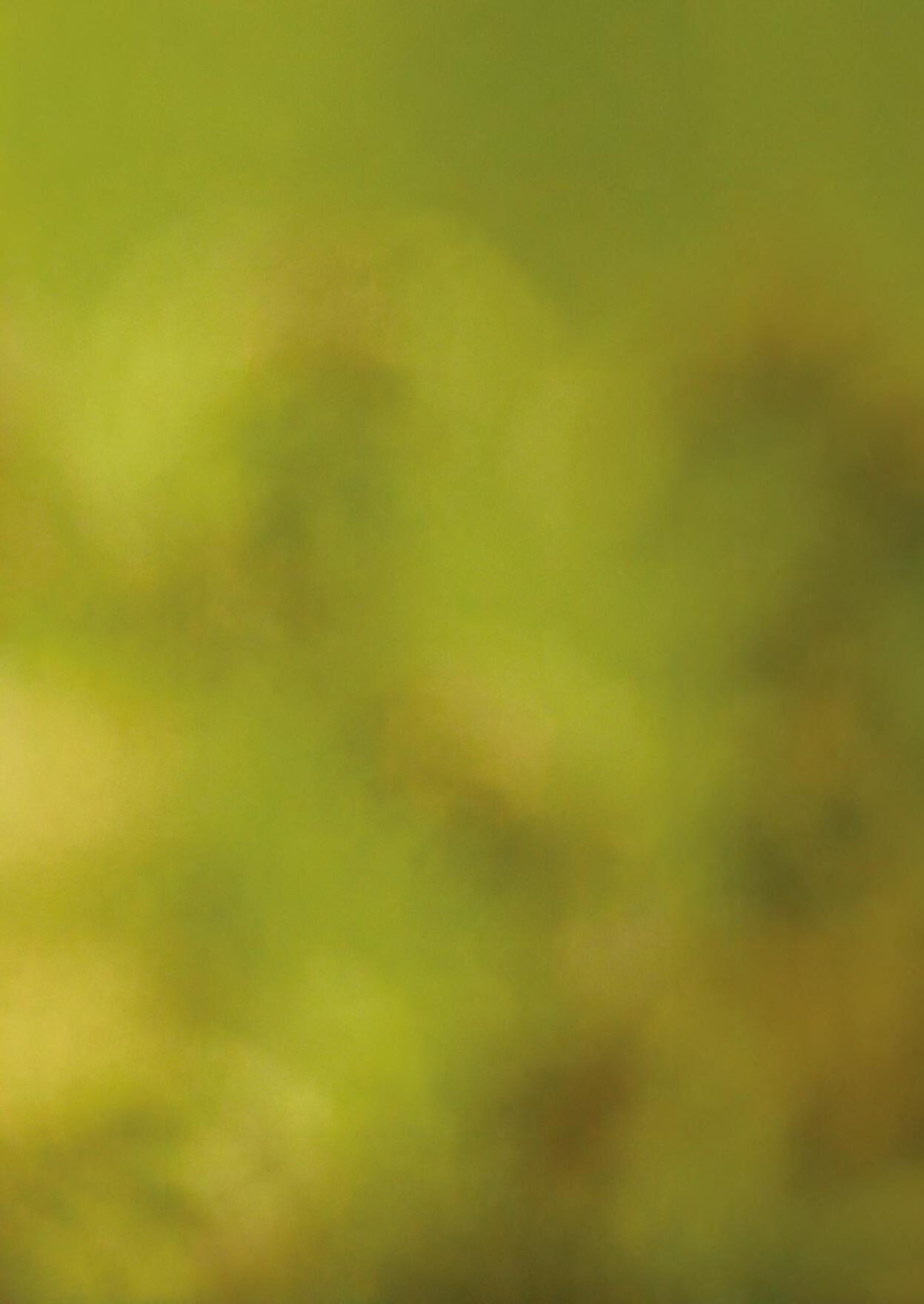
Best nature reserves to experience the dawn chorus this spring:
The dawn chorus starts around 30 minutes to an hour before sunrise, which may be as early as 4am in late spring.

1. West Wood nature reserve
2. Brookes nature reserve
3. Fingringhoe Wick Nature Discovery Park
4. Weeleyhall Wood nature reserve
5. Tiptree Heath nature reserve
6. Scrubs Wood nature reserve
7. Pound Wood nature reserve
8. Belfairs Wood
The dawn chorus begins in the twilight as the sun starts to emerge. At this notice of a new day ahead, songbirds burst into a symphony of whistles, chirps and trills. In the northern hemisphere, the chorus is performed mainly by male birds in the passerine group.
Although most species contribute to the chorus, the symphony builds as time goes on, as different birds join the chorus at different times. Nightingale, robin, song thrush, and blackbird all begin singing an hour or more before sunrise. As light levels increase, they are joined by wren, blackcap, chiffchaff and great tit, before late singers such as chaffinch finally make their entrance. Eventually, the chorus peaks and the cacophony of birds singing unifies to become a single, extraordinary, song.
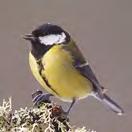


Chiffchaff




Singing at dawn is of such significance to birds, that they remain motivated to do so despite the clamour and competition of many others, which could overwhelm and distort their own song.
Several theories have been proposed to explain why birds sing most intensely at dawn to create this spectacle of sound. These factors can be grouped into three broad categories:
1. Intrinsic
Including hormone production and energy reserves.
2. Environmental Influenced by light levels, climate and habitat.
3. Social Based upon mate attraction, territory defence and social interactions.
Here, we explore some of the leading theories.
A widely accepted explanation for the timing of the dawn chorus is the level of light available. Although birds are active at dawn, there is not enough light at this time to forage sufficiently for invertebrates and seeds. Instead, as dawn breaks, birds use this period of the day to sing for a mate until the light returns. Shortly after sunrise, singing ceases because energy levels are low and foraging is now an important task. When energy levels are replenished, birds may alternate between singing and foraging throughout the rest of the day.
During the breeding season, female birds lay one egg every 24 hours at dawn and are at their most fertile up to two hours following laying. It is vital to her partner that he is present at this time. As such, it has been suggested that dawn song acts as a paternity assurance, and guards against neighbouring males seeking to steal their mate. Once the female has emerged from her roost after dawn, the male stops singing and actively protects her. This behaviour has been observed in great tits, but the theory does not apply to birds that are without a mate. Yet, many unmatched males sing at dawn. If dawn song is linked to female fertility, as the theory suggests, these males may be singing at dawn to attract another male’s fertile female
Another theory for why birds sing at dawn is that sound travels better at this time of day. To achieve their great symphony, birds must sing at the optimal time. At dawn, a microclimate occurs that improves the transmission of song. In particular, wind speed and atmospheric turbulence are reduced. In wooded habitats, changes in temperature can help bird song travel further. At dawn, the rising sun warms the air above the tree’s canopy quicker than the air in the shade beneath. Sound travels faster in the warm air above the canopy, and this acts to bend the song back down into the woodland.


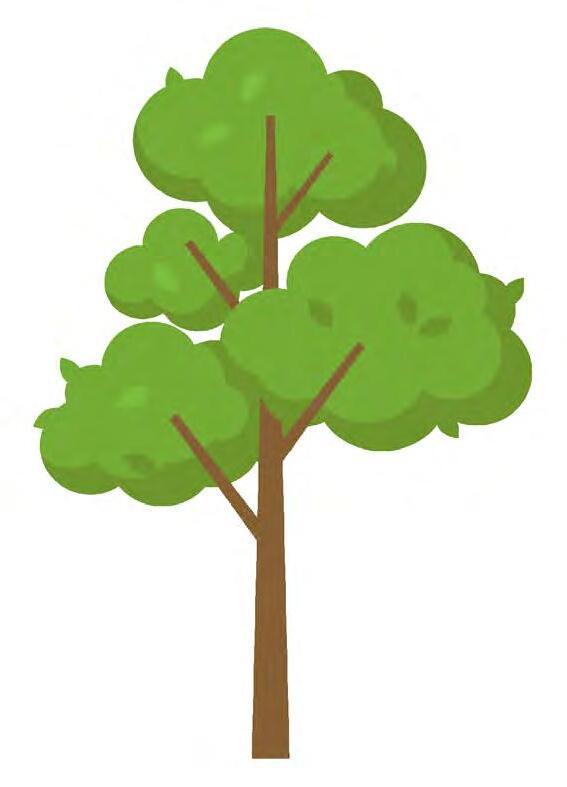
Scan the QR code to listen to a dawn chorus or visit our page on YouTube.
from their territories and replaced them with a speaker that played their song. Despite the birds being removed, rival males delayed their return to the area because of the song alone.
If the temperature beneath the canopy remains the same towards the ground, the song will not be distorted by temperature changes and the song carries further. By midday, a complicated temperature gradient forms within the woodland, and the favourable conditions are lost.
Perhaps the most convincing evidence that singing at dawn is used to defend territories is provided by migratory species. When males arrive at their breeding grounds and await their female counterparts, song is used as a tactic between male birds to establish dominance and territorial boundaries. Research suggests that when male nightingales arrive at their breeding grounds, they search for territories at dawn, triggering the nightingales that are already present to sing defensively to ward intruders away.
Experiments have shown that singing at dawn is a powerful defence mechanism. Researchers removed male great tits
The superior male Singing is a costly exercise for birds because of the energetic demands of producing song. Such behaviours can develop in the natural world, as there's competition to find a mate. If it is difficult to do and uses lots of energy, singing can signal the quality of a male bird. Singing at dawn may advertise an abundance of energy at a particularly costly time of day. In blue tits, older, fitter males start singing earlier, and amongst these older males, those that sing earlier attract more mating partners.
All of the theories presented above have been supported by researchers and rejected by others, and there is little consensus as to which, if any, is most applicable. In fact, it is widely recognised that a single theory cannot account for dawn song in all species and individuals, and it is likely that several or all theories apply at varying degrees throughout the breeding cycle. Although we do not understand exactly why the dawn chorus occurs, we can still enjoy this natural spectacle from April to June each spring – as long as you do not mind setting your alarm early!
 Stuart Brooker Lead Reserves Ecologist
Stuart Brooker Lead Reserves Ecologist
It has been an absolute pleasure to bring back our pledger events this year. We run these events annually as our way of saying thank you to the wonderful people who have pledged to leave Essex Wildlife Trust a gift in their Will. After several years of not being able to run these events, it has been a privilege to get to know our inspirational pledgers and hear the reasons why they have included us in their future planning.
For each event, we took a guided walk around one of our reserves.
In June, we explored Pheasant Farm led by Neil Bedford, our Nature Reserves Manager for the north of the county. He updated us on the fascinating work happening at the reserves that make up Danbury Ridge. Thanks to our expert tour guide, we were able to see and learn about several interesting sights that we may not have otherwise spotted, such as the raised bog and some of the recent coppicing works.

On a gloriously sunny day in October, we set out to Gunners Park in Shoeburyness, this time aided by Andrew Armstrong, Senior Ranger for South Essex, and Dan Garrun, Gunners Park Ranger. Our experts took us on a guided walk to see the plethora of migratory birds that visit the site. We not only learned about the very niche habitats that this reserve offers but also the historical importance of this former military site.
For some of our pledgers, a long walk isn’t always possible, so we have organised several bespoke visits to various reserves where the warden took us out in their 4x4 to avoid walking too far. We want to thank as many of our amazing pledgers as possible with a special visit to the areas that they help to conserve. Therefore, if you receive an invitation later this year and can’t make the set dates, don’t have transport or don’t feel
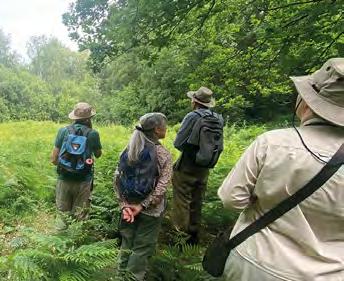
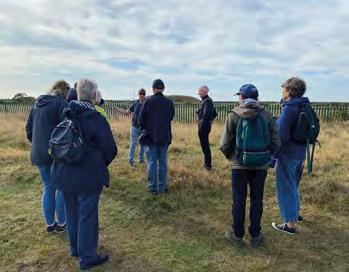

the walk is for you, then please do let us know. We can work around this to ensure you still experience our reserves and how your gift will make a difference.
We are enormously grateful to all who remember Essex Wildlife Trust in their Will, as they enable so many projects to come to fruition, helping us to protect Essex wildlife for future generations.
If you are thinking of leaving a gift to Essex Wildlife Trust in your Will, please visit our website at www.essexwt.org.uk/ gifts-in-wills or contact our Legacy Team on 01621 735233 who can guide you through the process. SCAN

Our Tree of Life at Fingringhoe Wick and Hanningfield Reservoir Nature Discovery Centres allow supporters to remember a loved one, celebrate a joyous occasion or recognise an individual’s love of the nature reserve. All proceeds go towards helping us protect wildlife for perpetuity.
With your support:
A bronze leaf (3 years) could help us to buy five bat boxes for our reserves.
A silver leaf (5 years) could fund a large bee hotel, benefitting solitary bees.
A gold leaf (7 years) could help us pay for a new field gate on a reserve or buy 4kg of native wildflower seed mix to help stop the decline of insects.
A bird (8 years) could help us create or restore a pond, or carry out essential rotovating work in wet grasslands to increase the number of invertebrates, providing more food for breeding waders.




To find out more, visit www.essexwt.org.uk/tree-of-life or contact our Legacy Team on treeoflife@essexwt.org.uk
As spring leaps into high gear and the days dawn a little earlier, jewelled butterflies emerge in a flurry of colour. Why not welcome them into your garden by creating a refreshing butterfly puddler to quench their thirst? A butterfly puddler allows our fluttery friends to rest and extract moisture and important minerals found in the mud or sand. This can help aid their survival and allow them to reproduce more successfully. Enjoy watching the butterflies as they flutter to your garden for some puddling fun!
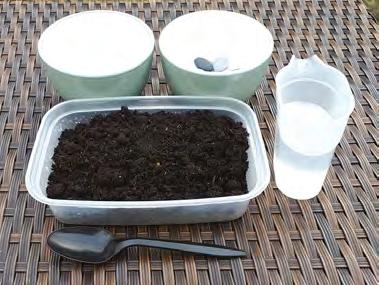
Gather all your materials - go for a walk and collect some stones to encourage beautiful butterflies to land in your puddler.

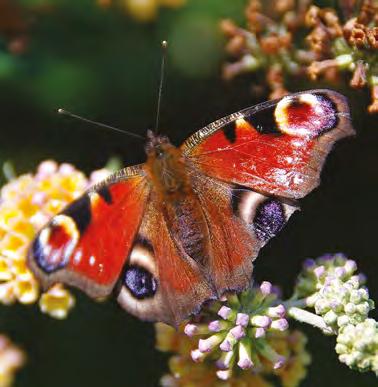
• A small bowl (preferably no higher than 3 inches)
• A few stones in varying sizes • Soil or sand • Fresh water

Step 1
Fill the bowl to the top with your choice of soil or sand.

Keep the soil topped up with water so it’s moist. Butterflies cannot land on open water, so this allows them to drink.
Step 3
Place a few stones around the edge of your bowl for butterflies to perch on.

If you make your own butterfly puddler, we’d love to see it. Send your pictures to magazine@essexwt.org.uk
Step 4
Place your puddler in a protected area, preferably somewhere sunny and near flowers so that they can keep warm.

Children have a huge appetite for nature. There’s an enormous world of wonderful wild things for them to discover, if they’re given the opportunity. The right experiences can build a connection to nature that will last a lifetime.
But as children get older, there are more distractions. Interests and hobbies are more likely to be influenced by friends than parents, or by the content they view online. If nature hasn’t fully captured their attention by now, that interest can slip away – though it often resurfaces later in life. So it’s important that we foster that connection to nature from as young an age as possible.
We worry about children’s access to technology being a blocker to spending time outside and connecting with nature. But I think technology can actually play a helpful role in breaking down barriers. As with everything, it’s all about balance. Often we’re out and about in nature, there’s wildlife around us, but we don’t really know what we’re seeing. Putting a name to the things we see or hear can help build an interest, and there are some incredible apps available to help with that, like Merlin Bird ID. You can even use them as a family and learn together.
The way we interact with the world has changed. Computers, apps, social media –they aren’t going away anytime soon. We can embrace them to spark children’s creativity. You can go online and find a tutorial for making pinecone creatures or other wildlifeinspired crafts, or follow role models using their digital platforms to inspire change. We’re seeing a fantastic rise in young nature activists, almost mini celebrities amongst young people. It’s a wonderful thing.

The more our young people care about the environment and nature, the better hope we have for a green and sustainable future. But it’s about far more than that. There’s so much evidence to show that young people who have that connection to nature, who experience nature in their daily lives, are happier and healthier. There are many reasons to encourage children to pursue an interest in nature, and happier children is a big one.
Knowledge of the natural world – and the state it is currently in – can sometimes feel like a burden as well as a blessing. Many of us worry about the future. The climate is changing and we’re seeing huge losses of wildlife. Children are not immune to these fears, and we shouldn’t try to hide the truth from them. But the way we present these facts matters. It’s easy to drown in the negative, but that won’t help to change things.
The most important thing we can do as adults is empower young people to feel like they can actually do something, and that their voice matters. We can help alleviate their climate anxiety by showing them that they can get involved with doing something good for the planet, wherever they live. The best place to start is by setting an example for them to follow, in the way we view nature and the actions we take to help it. If children see the adults around them caring, listening to the concerns, and taking meaningful action to help, it can be a huge inspiration.
Technology can help you connect with wildlife from the comfort of your own home. Check out our webcams
wildlifetrusts.org/webcams
For ways to help the young people around you to nurture a connection to nature, visit The Wildlife Trusts’ Wildlife Watch website. You’ll find downloadable wildlife spotter guides, self-guided activities and actions to help wildlife and more.
Get inspired at wildlifewatch.org.uk
Maddie Moate is one of the few familyfocused ‘Edu-tubers’ in the UK and has been creating fun educational science videos for the past eight years, amassing more than 210,000 subscribers and over 56 million views on her own YouTube channel.
Spring is finally here. Get outside to enjoy the gentle warmth of the sun, the sweet smell of blooming flowers and birds singing in the trees. We have lots of events, themed workshops and guided walks at your local Nature Discovery Centre to make the most of this vibrant time of year.
Abberton Reservoir Nature Discovery Park
Church Road, Layer-de-la-Haye, Colchester, CO2 0EU 01206 738172 / abberton@essexwt.org.uk
The first signs of spring that excite us at Abberton are hearing the skylarks singing again, and then the cowslips emerging in the meadow at the front of the Centre. We will be running many spring events such as our stargazing evenings and our popular jazz evening on Saturday 18 May. Please check our Facebook page for further details of upcoming events at www.facebook.com/EWTAbberton
Karen Latham, Assistant Centre Manager
Belfairs Nature Discovery Centre
Eastwood Road North, Leigh-on-Sea, SS9 4LR 01702 477467 / belfairs@essexwt.org.uk
Belfairs will be hosting some great spring events. We have our regular Easter activities – trails, crafts and family sessions as well as some adult crafting activities. For dog lovers we will also see the return of our exciting dog show in May. Wellbeing walks take place every Tuesday and are free to all. Make sure to check our Facebook page for more details at www.Facebook.com/EWTBelfairs
Greg Borgartz, Site Manager
Hanningfield Reservoir
Nature Discovery Park
Hawkswood Road, Downham, Billericay, CM11 1WT 01268 711001 / hanningfield@essexwt.org.uk


Bedfords Park Nature Discovery Centre
Broxhill Road, Havering-atte-Bower, RM4 1QH 01708 748646 / bedfords@essexwt.org.uk
Spring at Bedfords Park is an exciting time. The red deer hinds will be delivering their fawns; you can watch their tentative first few steps in our deer enclosure. The wildflower meadows spring to life with carpets of creeping buttercups, meadow buttercups and cow parsley. Hear the woodpeckers knocking and watch the buzzards and kites soar with the distant London skyline behind. Essex never looked so good!
Verity Collins, Site Manager
South Green Road, Fingringhoe, Colchester, CO5 7DN 01206 729678 / fingringhoe@essexwt.org.uk
We will be welcoming back our nightingales this spring. We work hard to maintain a habitat that encourages nightingales to thrive and we have one of the best populations in Essex. We’ll run a series of late nights and guided walks for a chance to hear nightingale’s rich repertoire from the 26 April - 16 May. Keep an eye on our Facebook page for event details at www.facebook.com/EWTFingringhoe
Verity Hales, Site Manager
Spring has arrived at Hanningfield and with it comes the new growth in the woodland and carpets of bluebells sprouting. We will be running a bluebell walk on Sunday 28 April with our Ranger Bill, come along to admire these beautiful spring sights. The Wilder Learning Team will also be running lots of Easter holiday events, look out for more details on our Facebook page at www.facebook.com/EWTHanningfield Justin Collins, Site Manager


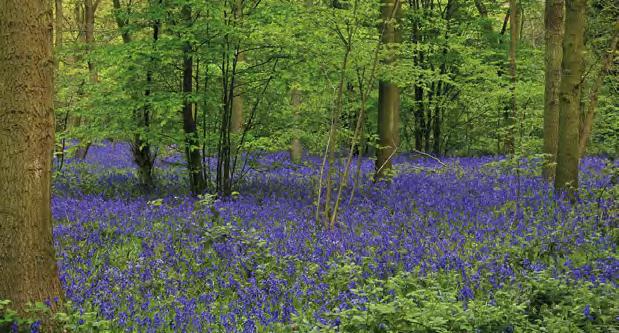
Hornchurch Country Park, Squadrons Approach, RM12 6TS 01708 520364 / ingrebourne@essexwt.org.uk
We will be introducing several wellbeing walks to encourage visitors of all ages to get out in nature and benefit from the wonderful sights, smells and sounds of spring. Also not forgetting our military heritage; there will be exhibitions in our Centre starting in May with Victory in Europe Day. Further information is available on our Facebook page at www.facebook.com/EWTIngrebourne
KateTyler, Assistant Centre Manager
Lower Dunton Road, Basildon, SS16 6EJ 01268 419103 / langdon@essexwt.org.uk
Langdon Nature Discovery Park is beginning to bloom with the awakening of snowdrops and daffodils. We have a new Site Manager, Ben, with lots of exciting and fresh ideas for the future. Thanks to our long-standing volunteer, John, our popular plant sale will be returning on the last bank holiday in May. Also look out for quiz nights, guided walks, fun drop-in sessions during the school holidays and more. We look forward to welcoming you on your next visit!
Yasmin Ward, Assistant Centre Manager

Old Hall Lane, Walton-on-the-Naze, CO14 8LE 01255 679379 / naze@essexwt.org.uk
March is one of the last opportunities to see our winter waders, ducks and geese, before they depart for breeding grounds in the Arctic. We then start to welcome back our spring migrant birds such as sand martins, cuckoos, common chiffchaff, northern wheatear, common whitethroat and willow warblers. See our Facebook page for information on all the events and workshops at www.facebook.com/EWTNaze
Helen Daw, Assistant Centre Manager/Visual Merchandiser
Thameside
Mucking Wharf Road, Stanford-le-Hope, SS17 0RN 01375 643342 / ttnp@essexwt.org.uk
The sun is starting to shine again and following the great success of Phoenix Striders '10 for 10' anniversary runs last year, there will be another series of cross country runs on Sunday 26 May at Thameside Nature Discovery Park. With exclusive access to the site for the 5 and 10km routes, get your running shoes on and join us. There will also be a child friendly 1km that loops round the play area. Look out for more details on our Facebook page at www.facebook.com/EWTTNDP
Jimmy Allan, Site Manager
As they grow, stems lengthen and the promise of flowers arrives. Buds develop.
Seeds in the ground stretch out their roots, pop out a sprout and begin to grow, emerging as seedlings.
Early spring sees the appearance of vibrant yellow flower heads, making them a perfect food source for early bees, birds and butterflies.
What is named after a lion’s razor-sharp teeth, prized by birds and butterflies alike and undergoes a total transformation throughout its life? This mysterious being changes its get-up from a spectacle of golden rays to a ball of wispy whites in a matter of days. With one last trick up its sleeve, a gust of wind triggers an explosion of fluffy parachutes. Did you guess? It’s none other than the common dandelion.
The petals dry out over the course of a week, exposing a seed head with white tufts peeking out.
The seed head opens, revealing a perfect sphere of fluffy cotton-like seeds.
With a gust of wind, the seeds say goodbye to their brothers and sisters as they each follow their own journey through the air until they settle on the ground.
Forget being a weed, dandelions are a wildflower we need Dandelions provide lots of nectar and pollen to vital pollinators come springtime. If you can, let them flourish.
There is a reason that wildflowers can often be found at the forefront of folklore. Who wouldn’t be inspired by a rolling hill of eye-popping poppies or a meadow of beautiful buttercups as far as the eye can see? Whether a cowslip or cornflower, all emerge from the undergrowth to brighten our landscape and mark so vividly the start of spring. Whether you’re a primrose pro or a nettle newbie, here are our top spots to go wildflower hunting this season.

Danbury Ridge nature reserves
A mosaic of woodlands, heathlands, commons, streams and bogs. The slow-growing wood anemone can be spotted across these reserves and it’s worth the wait. It will sure feel like spring has sprung at Danbury Ridge as you’ll spot bluebells beneath the branches too.
Best time to visit: April

Langdon Nature Discovery Park
461 acres of woodland, meadows, lakes and former plotland gardens. Over 350 wild flowering plants have been recorded here including both green-winged orchids and cowslips over the spring months.
Best time to visit: Late April and May
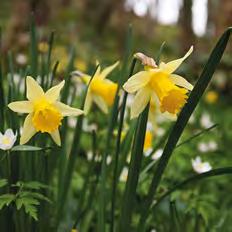
Warley Place nature reserve
Daffodils are definitely the star of the show at Warley Place. But you can also discover snowdrops, crocuses and bluebells across the 25-acre reserve.
Best time to visit: March and April

Hanningfield Reservoir Nature Discovery Park
Bonkers for bluebells?
Hanningfield will not disappoint. Beneath the branches of the mature woodland, gaze upon the vast carpet of vibrant bluebells. It really is a ‘site’ to see!
Best time to visit: April

Roding Valley Meadows nature reserve
A lover of damp habitat, gaze upon the pale pink petals of the cuckooflower at Roding Valley Meadows, the largest remaining species-rich water meadow in Essex.
Best time to visit: April and May

Please keep to footpaths as you hunt for wildflowers this spring as these early bloomers are particularly sensitive to trampling.
West Wood nature reserve
Only found in this small area of East Anglia, the oxlip shows off its pale yellow petals in abundance at West Wood. Come back in early summer for greater butterfly orchids too.
Best time to visit: April

Don’t forget to record all your wildflower sightings between 1 April – 30 September to take part in The Essex BioBlitz. You don’t have to be an expert to take part. Find out more about our largest citizen science project at www.essexwt.org.uk/ essex-bioblitz











01206 764477
www.ellisonssolicitors.com

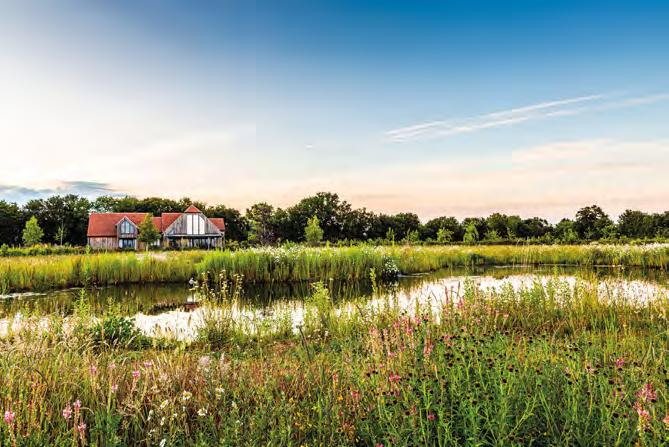
We
Adaptable to any ceremony and a completely personalised service.
Reserving a plot in advance is also possible.
01245 806332
oldparkmeadow.co.uk
Coppice Lane, North End,
Chelmsford & Great Dunmow, Essex, CM6 3PL



he creation of the first Highly Protected Marine Areas in English water made 2023 an historic year for marine conservation. This huge milestone was achieved thanks to years of campaigning by The Wildlife Trusts’ sea-loving supporters. The new gold-standard of protection will stop all damaging activities such as trawling and will help marine life to recover, benefitting fishers and boosting carbon storing habitats at sea. These special places cover less than half a percent of English seas though, so it’s just the first tiny step towards better protected seas.
Marine areas weren’t the only reason to celebrate last year, with The Wildlife Trusts’ Marine Review 2023 also showing an exciting rise in sightings of apex predators – those at the very top of the food chain – in our seas. One species that created an incredible spectacle off the UK coast this year was bluefin tuna. Dan Abbott, cinematographer, witnessed a bluefin tuna feeding event in UK waters. He said: “The first indicator that something exciting was about to happen was seeing lots of seabirds – mainly gannets and shearwaters –gathering. As they have an aerial view, seabirds can often be a great indicator of where fish and marine mammals may be below the surface. As the tuna feed, the surface appears like boiling water as these
After almost completely disappearing from UK seas, bluefin tuna made a comeback in 2023
powerful and agile fish speed through the sea.” Atlantic bluefish tuna were once common in UK waters, but overfishing caused numbers to plummet during the 20th century, with the fish all but vanishing from our waters by the 1990s.
Humpback and fin whales, which were once more common around our coasts, also showed promising signs of recovery in 2023. Humpback whales were seen off Burhou, a small island northwest of Alderney (part of the Channel Islands) and off Cornwall. There were also increased sightings of Northern fin whales, the second largest mammal in the world. Meanwhile it was a bumper year for Risso’s dolphins, with 156 sightings in 2023, compared to 45 in 2022! Reports of ‘super-pod’ feeding frenzies were reported, with common dolphins and fin whales joining in.
It wasn’t all good news however, as in contrast to these wins, the global pandemic of avian flu has sadly continued to devastate UK seabirds. While there are signs that some birds are showing immunity, vast numbers have been lost.
Discover more about our 2023 marine review here wildlifetrusts.org/news/marine-review
Basic rules that help protect hedgerows and rivers on or surrounding farmland expired on 31st December 2023, with nothing to replace them – putting wildlife in our countryside at greater risk of harm.
These rules, known as ‘cross compliance’ had to be followed by farmers if they wanted to receive rural farm payments from UK Government between 2005 and 2023. To qualify, farmers were not permitted to farm up to the edge of rivers, so as to help prevent soil and farm pollution from being washed into the water. There were also rules about when hedgerows could be cut so that breeding farmland birds were protected at the most important times of year.
Following the UK’s exit from the European Union, the UK Government announced that this rule would cease to exist at the end of 2023, but that it would be replaced by new UK rules.
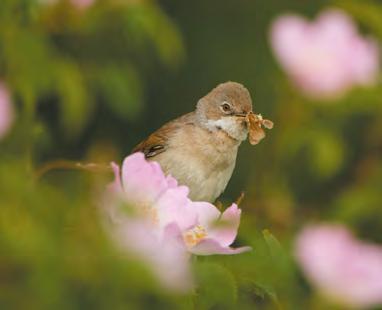
However, no new rules are in place, and the Government’s Department for Environment, Food and Rural Affairs (Defra) has not confirmed whether these protections for nature will be maintained. Meanwhile, nature on farms is in limbo, with nesting birds in danger and our already struggling rivers and streams at risk of increased pollution.
The Wildlife Trusts have joined forces with National Trust and RSPB to urge the UK Government to uphold protections for nature while providing much better support for farmers. We would like to see farmers paid to take a ‘whole farm’ approach to naturefriendly farming through better designed payment schemes and access to quality independent advice on the best actions that can be taken on their farms.
Find out more at wtru.st/hedgerows

With a general election expected in 2024, The Wildlife Trusts have been investigating how much nature matters to our supporters and the general public, and whether the nature policies set out by political parties will influence how they vote.
We carried out two nationwide surveys, which revealed that environmental charities are supported by a large and politically diverse range of people – with voters feeling similarly connected to nature, regardless of where they identify on the left to right wing spectrum.
Results from Wildlife Trust supporters indicated that 61% would vote based on environmental policies and a further 32% are considering doing the same. Of all those surveyed (including nonsupporters), only 7% didn’t believe that nature loss or climate change were a serious threat to humanity.
The upcoming general election will be vital for our natural world, and these results suggest that voters are calling on all political parties to make bold plans to restore nature, tackle water pollution and halt climate change.
Discover how
The Wildlife Trusts are helping wildlife across the UK

The Great Scottish Squirrel Survey had more participants than previous years, with just under 2,000 red and grey squirrel sightings across the country. Every record helps Scottish Wildlife Trust to understand population distributions and take targeted action to protect red squirrels. Sightings of both species can be reported all year-round. wtru.st/squirrel-sightings
Nottinghamshire Wildlife Trust is set to bring UK’s fastest declining mammal, water voles, back from the brink. Half a million pounds from Natural England’s Species Recovery Programme will create vital wetland habitat and restore 50km of rivers to increase water vole numbers. wtru.st/notts-water-vole

One of our most bizarre and beautiful rare birds, the curlew, is to get £230k worth of home improvements at Berkshire, Buckinghamshire & Oxfordshire Wildlife Trust (BBOWT) Gallows Bridge Farm nature reserve. New pools, security cameras and anti-predator fencing will help to create new bespoke habitat for this endangered species. wtru.st/curlew-habitat

...WILD Spring 2017 as we read about the efforts of our conservation team to help declining turtle doves.
Turtle doves are at serious risk of local extinction.
They have suffered a 91% population decline in the UK since just the mid-1990s and a 78% decline across Europe since 1980 (RSPB, 2017).
These facts reveal the stark reality for a wonderful bird that was once common in our countryside.

Persecution on its migratory route from Africa is one well-documented cause of the turtle dove’s decline. But even when birds do reach us, breeding habitat and food supplies have been shrinking. Essex Wildlife Trust, as part of the RSPB’s ‘Operation Turtle Dove’, is working in partnership with other landowners to reverse the turtle dove’s bleak fortunes, through specific habitat management.
These birds need three key components to their UK breeding habitat: thorny scrub (between 2m and 5m), fresh water and open, weedy feeding areas. On many reserves we have scrub and fresh water, but few open, weedy agricultural areas. Lack of seed food is probably the major factor limiting the breeding success of turtle doves. Therefore, establishing these ‘Turtle Dove Feeding Plots’ is essential to ensuring that optimum habitat is provided.
So far, we have established plots at Two Tree Island (Leigh-on-Sea), Blue House Farm (Crouch Estuary) and Abberton Reservoir (south of Colchester). It is early days, but we are hoping to record turtle doves using the plots this summer. Other reserves where the birds were recorded last year included Wrabness (Stour Estuary), Fingringhoe Wick (Colne Estuary) and Abbotts Hall Farm (Blackwater Estuary).
• Donald Trump became the 45th president of the United States.
• An unexpectedly rich population of the almost extinct bird, the helmeted hornbill, was recorded in western Borneo.
• Researchers unveiled fossils of five early humans found in North Africa, changing the estimate of homo sapiens' existence to 100,000 years earlier than recognised.
• The first asteroid from interstellar space was spotted by Hawaiian scientists.
• One of the biggest icebergs ever recorded broke away from Antarctica’s ice shelf.

Since the conception of this project, further turtle dove plots were created at Brookes nature reserve, Sergeant’s Orchard nature reserve and Phyllis Currie nature reserve. Of these, only one site has recorded turtle doves – Sergeant’s Orchard. It is estimated that 99% of turtle doves have been lost since 1960s. Despite the efforts of the Trust, the loss of breeding habitats and hunting of these birds has severely contributed to their decline. However, it’s not all bad news. The plots have attracted other species, including stock dove, linnet, and yellow hammer. Positively, Wrabness and Abbotts Hall recorded turtle doves in 2023.




















How is your general knowledge on wildlife and the wild places of our country? Test yourself with our nature crossword.
Hint: You might find some helpful clues in this magazine.
2 Which type of animal is a slow worm? (6)
4 Which bird is famous for laying its eggs in other bird’s nests? (6)
5 Badger bedding changes prevent the build-up of what? (9)
6 Collective name for a group of hedgehogs. (7)
8 A beach-nesting bird with a red-orange bill. (13)
11 Which mudflat vegetation do dark-bellied brent geese feed on? (3, 5)
12 Butterflies taste using their what? (4)
Clues down
1 Which birds drums on trees using a strong beak? (11)
3 Which wildflower gets its name from lion’s teeth? (9)
7 Which coastal habitat is excellent at absorbing carbon? (9)
9 Which bird is a late singer in the dawn chorus? (9)
10 A purple flower that is abundant in spring. (8)
Tooth and snail
The common garden snail has 14,000 teeth, called radula.

The butcher bird
Shrikes, also known as the butchering bird, impale their prey on sticks to save them for later.

Eyes to the skies
Bees have five eyes, two at the front like a fly and three smaller eyes like a spider.
The answers will be revealed in our Summer 2024 edition of WILD













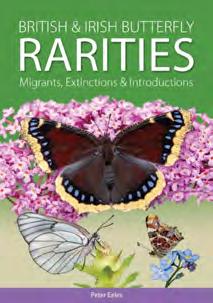

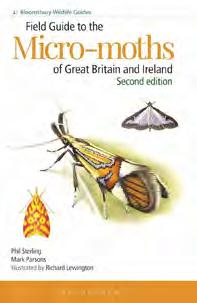


Sign up to take part in the UK’s biggest month-long nature challenge
wildlifetrusts.org/30DaysWild

Scan with your phone camera to sign up!